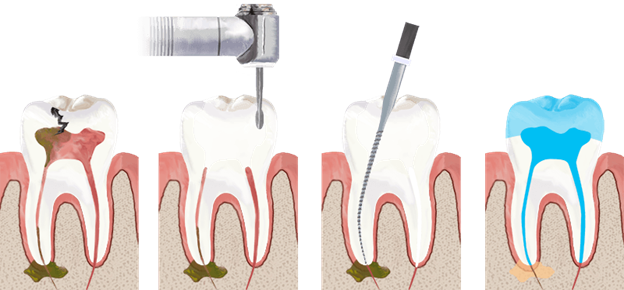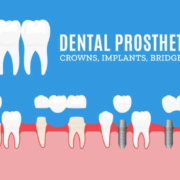A canal infection can be a painful and uncomfortable experience. It is important to understand the symptoms of an infected canal so that it can be treated appropriately and quickly. Root canal infections can occur when the pulp of a tooth becomes infected, usually caused by decay or trauma. Common symptoms of a canal infection include pain in the mouth, swelling, visible discolouration of the tooth, and a foul taste in the mouth. In more severe cases, a fever or facial swelling may be present. Thus, a root canal treatment may be advised.
What is a Root Canal infection?
A root canal infection occurs when the pulp inside the tooth becomes infected and dies. The pulp consists of blood vessels, nerves, and connective tissue, and acts as soft tissue inside the tooth. If a tooth becomes damaged by decay or trauma, the pulp can become inflamed and infected. If left untreated, a root infection can cause more serious issues, including tooth abscesses, tooth loss, and even spread to other organs.

Canal infections are most commonly seen in teeth that have experienced trauma, have had a previous root canal, or have had dental fillings. Root canal infections are also more common in people with diabetes or kidney disease.
Causes of Root Canal infections
Infected root canals can be caused by bacteria entering the root canal of a tooth through fractures, cracks, or holes. Bacteria can also be introduced through infected dental materials such as dental fillings, crowns, and bridges. Root canal infections can be caused by a number of different bacteria, most commonly Streptococcus, Staphylococcus, or Enterococcus.
Symptoms of Root Canal infections
Pain in the Mouth – A root canal infection can lead to pain in the tooth or nearby teeth. This pain can spread to the gums, jaw, or the roof of the mouth. The amount of pain experienced can vary from person to person and depend on the severity of the inflammation.
Swelling – Swelling around the infected tooth can occur due to an increase in inflammation, caused by the root canal infection.
Visible Discolouration of the Tooth – A visible discolouration of the tooth and surrounding gum tissue occurs due to an accumulation of blood and pus. The colour of the gum tissue and the tooth can vary, ranging from bright red to dark black.
Pus discharge that’s greenish, yellowish, or otherwise discoloured: Red, warm, swollen tissue near the tooth, especially the gums under or around the tooth — in some cases, swelling can affect your face and neck, too. tenderness or discomfort in swollen tissue, especially when you touch or apply pressure to it.
Diagnosing Root Canal infections
A dentist can diagnose a root canal infection by performing a thorough oral examination, checking for tooth mobility, and palpating for tender spots. The x-ray of the tooth can reveal a narrowed or widened canal, indicating the presence of an inflammation. However, an x-ray is not always necessary as the symptoms of a root infection are usually enough to warrant treatment if present.
After eradicating the infection from the tooth, a dental crown is placed over the area to protect the natural tooth from further damage. This is the gist of Root Canal Treatment. Generally, people are less concerned when it comes to a dental treatment. Hence, most patients avoid getting dental treatment done and also feel that dental procedures are very expensive and time-consuming as multiple visits are required. Root treatment is a very common dental procedure and can be carried out in one sitting.
Treatment to Root Canal Inflammation
Treating a canal infection involves removing the infected pulp inside the tooth, disinfecting the tooth, and sealing the root canal with a filling material. Root canal therapy is a treatment that removes the infected pulp inside a tooth, disinfects the tooth, and seals the root canal with a filling material. People with a history of root canal infections may be candidates for an “Endodontic re-treatment” or “re-root canal”, which is the reopening of a previously treated tooth to remove additional pulp tissue.

Preventing Root Canal infections
Preventing root canal infections involves routine dental examinations and cleanings, as well as healthy eating habits. It is important to visit the dentist at least once a year for a dental exam and cleaning. During the dental exam, the dentist will check for cavities, look at the health of your gums, and determine if any coronal buildup is present. Following a healthy diet that includes plenty of fruits and vegetables is essential for maintaining good oral health.
When to seek Medical attention
If you experience any of the symptoms of a root canal infection, it is important to see a dentist as soon as possible. Root infections can lead to tooth abscesses and tooth loss if left untreated. It is important to realise that not all pain in the mouth is caused by a toothache and that a root canal inflammation is possible even if there is no pain. If pain in the mouth is present. It is important to investigate the cause as soon as possible to prevent further complications from occurring.
Summary
A root canal infection is an infection that occurs when the pulp inside the tooth becomes infected and dies. The pulp consists of blood vessels, nerves, and connective tissue, and acts as soft tissue inside the tooth. The symptoms of a root canal infection include pain in the mouth, swelling, and visible discolouration of the tooth. And a foul taste in the mouth. A dentist can diagnose a root canal infection by performing a thorough oral examination. Checking for tooth mobility, and palpating for tender spots.






